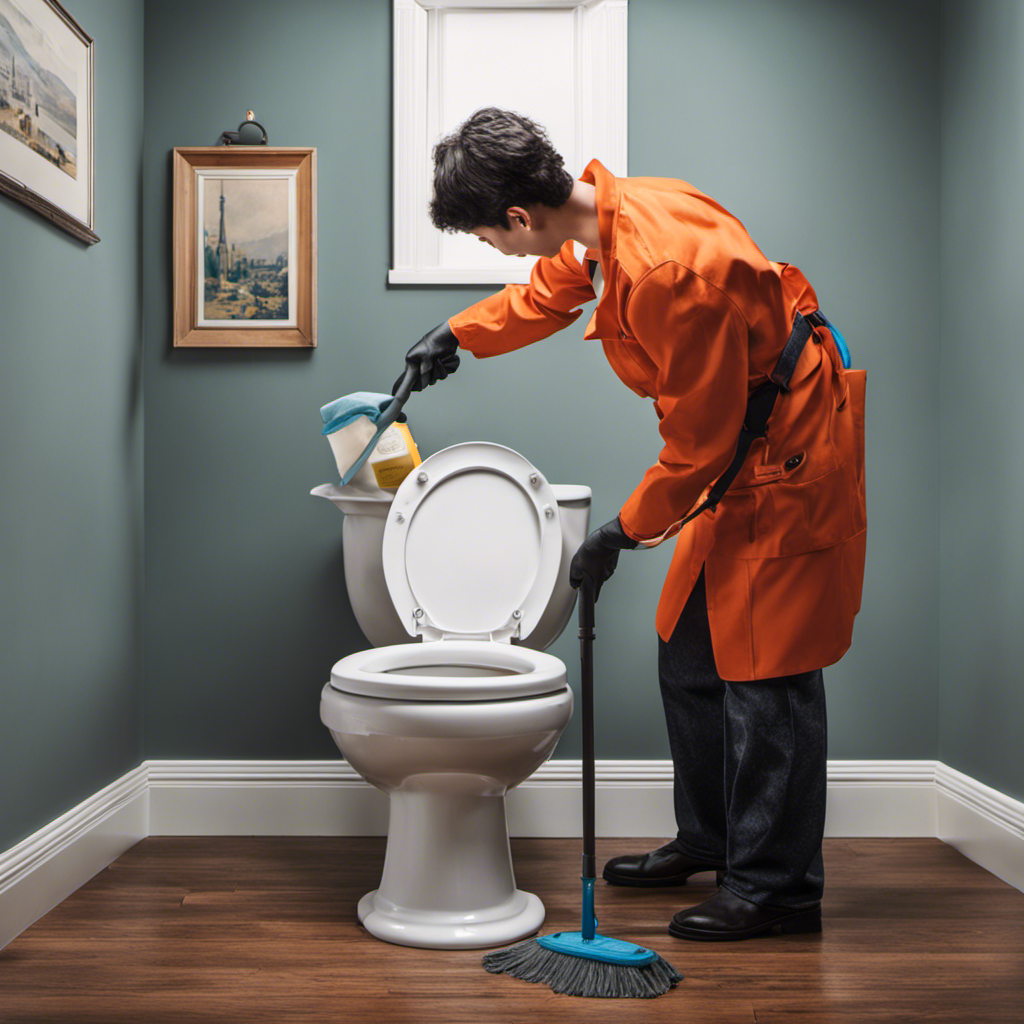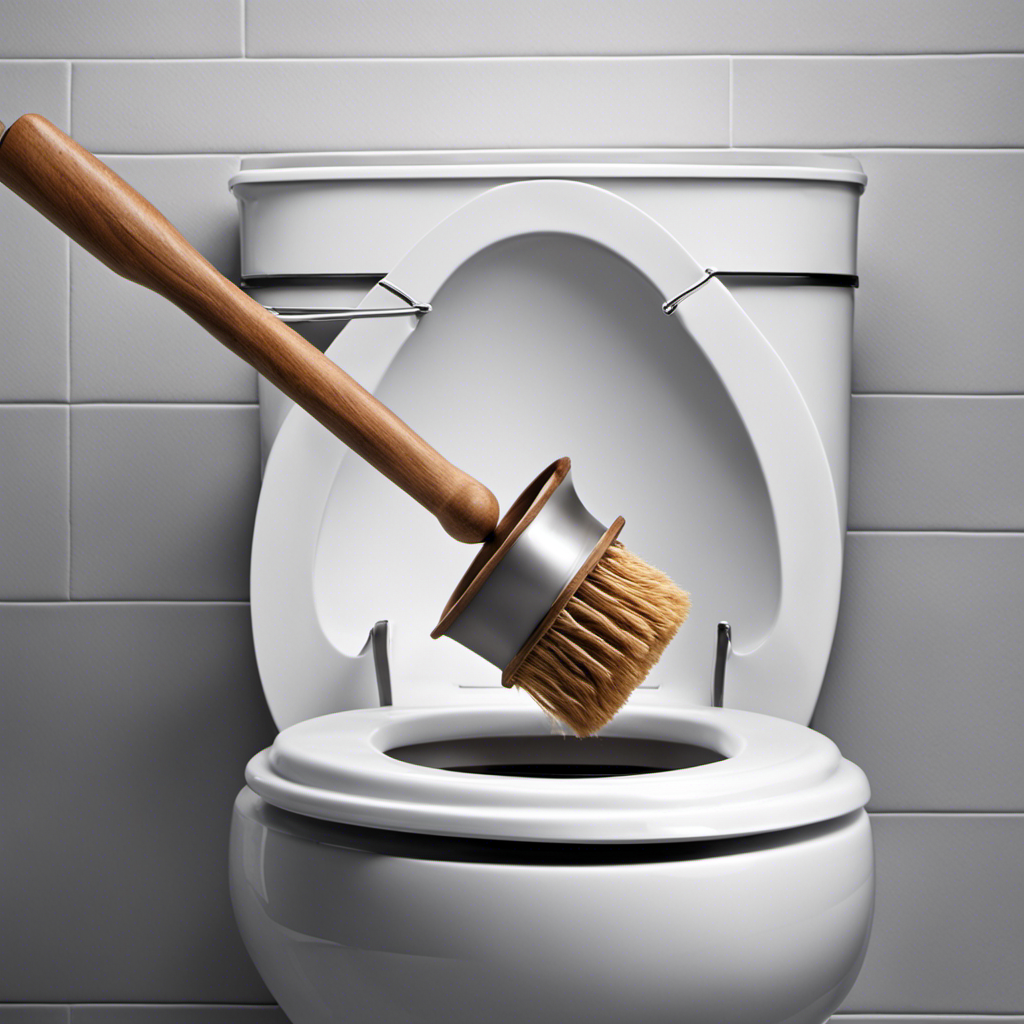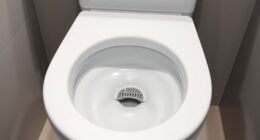Are you in a tight spot with a clogged toilet and no plunger in sight? Don’t panic! This article has got you covered. We will walk you through the step-by-step process of unclogging your toilet without the need for a plunger.
From understanding the causes of toilet clogs to utilizing natural alternatives like baking soda and vinegar, we’ve got all the effective techniques you need.
So, let’s get started and bid farewell to that stubborn clog!
Key Takeaways
- Excessive toilet paper usage and flushing non-flushable items can cause toilet clogs.
- Assessing the severity of the clog by determining its location and size is important.
- Alternative unclogging methods using hot water, dish soap, baking soda, and vinegar can be effective without a plunger.
- If all else fails, seeking professional help from a plumber is recommended.
Understanding the Causes of Toilet Clogs
Understanding the causes of toilet clogs can help prevent them from happening in the future. One of the main causes is excessive toilet paper usage. When you use too much toilet paper at once, it can easily get stuck in the pipes and cause a blockage.
Another common cause is flushing items that are not meant to be flushed, such as feminine hygiene products, baby wipes, or paper towels. These items do not break down like toilet paper and can accumulate in the pipes, leading to clogs.
To prevent toilet clogs, it’s important to use toilet paper in moderation and only flush items that are specifically labeled as flushable. By being mindful of what you flush, you can avoid unnecessary clogs and keep your toilet running smoothly.
Now, let’s move on to assessing the severity of the clog.
Assessing the Severity of the Clog
When it comes to assessing the severity of a toilet clog, there are a few key points to consider.
First, you’ll want to determine the location and size of the clog. Is it near the surface or deeper in the pipes?
Next, observe the water level in the toilet bowl to gauge how blocked the drain is.
Clog Location and Size
The first step is to determine where the clog is located and how big it is. By identifying the clog location, you can choose the most effective method to unclog your toilet without a plunger. Additionally, determining the blockage size will help you gauge the severity of the clog and guide your decision-making process. To assist you in this process, here is a table outlining various clog locations and their possible blockage sizes:
| Clog Location | Blockage Size |
|---|---|
| Bowl | Small/Medium |
| Trap | Medium/Large |
| Drainpipe | Large |
| Sewer Line | Very Large |
Water Level Observation
To determine the severity of the clog, start by observing the water level in the toilet bowl. This simple step can provide valuable information about the blockage and help you determine the best course of action. Here are four key things to look for when assessing the water flow and checking for blockages in your toilet:
-
Low water level: If the water level is significantly lower than usual, it could indicate a partial clog. This means that water is not flowing freely and there might be an obstruction somewhere in the pipes.
-
Slow draining: If the water takes longer than usual to drain after flushing, it could be a sign of a partial clog. The water might be struggling to make its way through the pipes, indicating the presence of a blockage.
-
Overflowing water: If the water level rises above the normal level after flushing, it suggests a severe clog. This can lead to an overflow, which can be messy and cause damage if not addressed promptly.
-
Gurgling sounds: If you hear gurgling sounds coming from the toilet bowl or drain, it could indicate a blockage. These sounds occur when air is trapped in the pipes due to an obstruction, causing the water to struggle to flow smoothly.
Attempting Alternative Unclogging Methods
By attempting alternative methods, you may be able to unclog your toilet without using a plunger. While a plunger is often the go-to tool for unclogging toilets, there are other effective techniques you can try using common household items.
One such method is the hot water and dish soap technique. Start by pouring a generous amount of dish soap into the toilet bowl. Then, carefully pour hot water into the bowl from waist height. The combination of the soap’s lubrication and the hot water’s force can help dislodge the clog.
Another alternative technique is the baking soda and vinegar method. Mix one cup of baking soda with one cup of vinegar and pour it into the toilet bowl. Let it sit for about 30 minutes, then flush the toilet. The chemical reaction between the baking soda and vinegar can help break down the clog.
Using Hot Water to Loosen the Blockage
Pouring hot water into the toilet can help loosen the blockage. Here are some key points to keep in mind when using this method:
-
Precautions: Make sure the water is hot, but not boiling, to avoid damaging the porcelain. Use caution when handling hot water to prevent burns.
-
Effectiveness: Hot water can be an effective way to break up clogs caused by organic matter. The heat helps to soften and dissolve the blockage, allowing it to flow through the pipes more easily.
-
Procedure: Start by heating a pot or kettle of water until it is hot, but not boiling. Carefully pour the hot water into the toilet bowl, aiming for the center. Allow the water to sit for a few minutes, then flush the toilet to see if the blockage has cleared.
-
Repeat if necessary: If the blockage persists, you may need to repeat the process or try another method.
Using hot water is a simple and potentially effective way to unclog a toilet. However, if this method doesn’t work, you can also consider employing baking soda and vinegar as natural alternatives.
Employing Baking Soda and Vinegar as Natural Alternatives
If you’re looking for a natural and effective alternative to unclog your toilet without a plunger, look no further than baking soda and vinegar. When combined, these two ingredients create a fizzing reaction that can help break down the blockage.
Baking soda also has cleaning properties that can help remove any residual odors or stains. It’s a simple and affordable solution that can save you from the hassle of using a plunger.
Baking Soda Fizz Reaction
You can easily create a baking soda fizz reaction to unclog your toilet. Here’s how:
-
Gather the necessary ingredients: baking soda and vinegar. These common household items have various uses, and when combined, they can create a powerful reaction.
-
Start by pouring half a cup of baking soda into the clogged toilet. Make sure it reaches the drain and covers the blockage.
-
Slowly pour one cup of vinegar into the toilet bowl. The vinegar will react with the baking soda, causing a fizzing action that can help dislodge the clog.
-
Let the mixture sit for about 20 minutes. During this time, the fizzing action will work to break down the blockage.
After the designated time, flush the toilet. The combination of baking soda and vinegar should have loosened the clog, allowing for a smooth flow of water.
Vinegar’s Cleaning Properties
To effectively use vinegar’s cleaning properties, mix it with baking soda to create a powerful solution.
Vinegar is not only a versatile ingredient in cooking but also a fantastic cleaner for your home. Its acidic nature makes it an effective disinfectant and deodorizer.
When combined with baking soda, the reaction creates a fizzing action that helps break down stains and remove dirt.
Vinegar’s health benefits are also worth mentioning. It is known to have antibacterial and antimicrobial properties, making it a natural alternative to harsh chemical cleaners.
Additionally, vinegar can be used to clean various surfaces, such as countertops, glass, and even stainless steel appliances.
Effective Plunger Alternative
Using a mixture of hot water and dish soap can be an effective alternative to using a plunger when unclogging a toilet. Here are four reasons why you should consider this method:
-
Cost-effective: Unlike a plunger, which you may have to purchase specifically for unclogging toilets, hot water and dish soap are readily available in most households. This makes it a convenient and affordable option.
-
Safe for your plumbing: Plungers can sometimes exert excessive pressure on your pipes, leading to potential damage. The hot water and dish soap method, on the other hand, is gentle and less likely to cause any harm to your plumbing system.
-
Environmentally friendly: Many commercial drain cleaners contain harsh chemicals that can be harmful to the environment. By using this natural solution, you can avoid introducing these chemicals into the water supply.
-
Easy and effective: The combination of hot water and dish soap helps to break down the clog, making it easier to clear. Simply pour a generous amount of dish soap into the toilet bowl followed by hot water, and let it sit for a few minutes before flushing.
Utilizing a Toilet Auger or Snake for Deep Clogs
If you’re dealing with a deep clog in your toilet, try using a toilet auger or snake to effectively clear the blockage. These tools offer several benefits over using a plunger. Firstly, a toilet auger or snake can reach deeper into the pipes, allowing you to tackle tougher clogs that a plunger may not be able to handle. Additionally, using an auger or snake can be more effective in breaking up stubborn blockages, as they provide a twisting motion that helps to dislodge the debris.
To give you a better understanding of the effectiveness of a toilet auger or snake compared to a plunger, here is a comparison table:
| Tool | Benefits | Effectiveness |
|---|---|---|
| Toilet Auger | Reaches deeper into pipes, tackles tough clogs | Highly effective |
| Snake | Provides twisting motion to dislodge debris | Very effective |
| Plunger | Limited reach, may not handle tough clogs | Effective, but less so than auger or snake |
Trying a DIY Toilet Unclogging Mixture
Now that you’ve learned about using a toilet auger or snake for deep clogs, let’s explore another option: trying a DIY toilet unclogging mixture.
These natural remedies can be effective and save you from the hassle of using a plunger. Here are four DIY toilet unclogging hacks you can try:
-
Baking Soda and Vinegar: Pour half a cup of baking soda into the toilet bowl, followed by one cup of vinegar. Let it sit for about 30 minutes, then flush with hot water.
-
Hot Water and Dish Soap: Add a few tablespoons of dish soap to a bucket of hot water. Pour the mixture into the toilet bowl and let it sit for a while before flushing.
-
Epsom Salt and Dawn: Mix 1 cup of Epsom salt with a few drops of Dawn dish soap. Pour the mixture into the toilet bowl and let it sit overnight. Flush in the morning.
-
Coca-Cola: Pour a can of Coca-Cola into the toilet bowl and let it sit for an hour. Flush with hot water to help break up the clog.
These natural remedies can be effective in unclogging toilets without a plunger. Give them a try before calling a professional plumber.
Seeking Professional Help if All Else Fails
When all else fails, it’s best to seek professional help for your clogged toilet. Sometimes, DIY methods may not be enough to tackle stubborn clogs, and that’s when calling a plumber becomes crucial.
Seeking professional assistance ensures that the problem is addressed effectively and efficiently, saving you time, effort, and potential damage to your plumbing system. Plumbers have the necessary tools and expertise to diagnose the issue accurately and provide the most appropriate solution.
They can also identify any underlying problems that may be causing the clog and offer preventive measures to avoid future occurrences.
Conclusion
In conclusion, when you find yourself facing the unfortunate situation of a clogged toilet without a plunger, fear not! There are several effective methods you can employ to tackle the issue head-on.
From using hot water to loosen the blockage, to utilizing natural alternatives like baking soda and vinegar, there are options available to you.
And if all else fails, don’t hesitate to seek professional help. Remember, with a little know-how and determination, you can overcome this messy predicament and restore your bathroom to its former glory.










